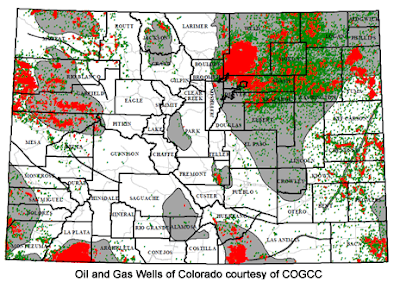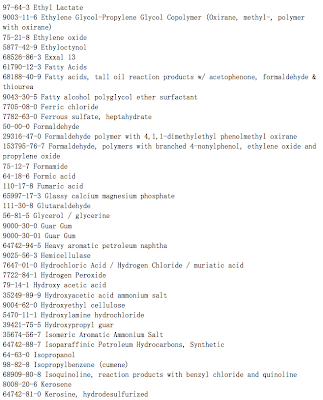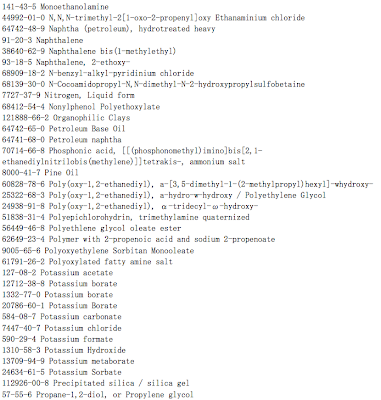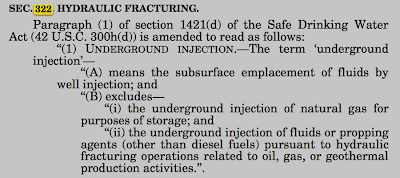A recent study published in Endocrinology looks at the chemicals used in fracking and finds that the contamination of both ground and surface water by the more than 750 chemicals used in the process is not insignificant when measured in terms of their endocrine-disrupting nature with a recent study showing that over 100 of these ingredients having the ability to cause negative health effects through the human endocrine system. These chemicals are termed endocrine disrupting chemicals or EDCs. EDC's have the ability to mimic or block the effects of the body's reproductive hormones and exposure to these chemicals has been linked to birth defects, cancer and infertility.
The authors from the Department of Obstetrics, Gynecology and Women's Health and the Department of Health Management and Informatics, both at the University of Missouri and the United States Geological Survey, collected water samples in Garfield County, Colorado where the drilling density is high (there are more than 10,000 natural gas wells in the area) and fracking is commonly used in drilling operations. Looking at the bigger picture in Colorado, there are now about 30,000 active wells in the state, up markedly from 5700 twenty years ago. In the study, unique water samples were collected from five fracking fluid spill sites, two reference sites and the Colorado River. These samples were tested for twenty-four chemicals used in natural gas drilling operations and were measured for both estrogen (female) and androgen (male) receptor activities in human cells.
Let's open by looking at at map of Colorado from FracTracker showing the outline of shale basins (in light orange) and shale plays (in pink), where directional wells are being drilled in the state (in dark orange) and where spills from directional wells have taken place (in yellow):
Here is a map showing the outline of counties in Colorado along with oil wells (in green) and gas wells in red), noting that Garfield County is located in the northwest quadrant of the state:
As an aside, spills of fracking related fluids were of recent concern to Colorado state officials after flooding in September 2013 damaged areas in northern eastern Colorado that had high concentrations of oil industry infrastructure as you can see on the map. With over 50,000 drill sites in Colorado alone, the problems with spills and related contamination of both surface and subsurface water could be catastrophic.
As further background, estrogen and androgen receptors are proteins that are found within human cells that are activated by these two hormones. Estrogen and androgen influence much of human physiology including reproduction, cardiovascular health, cognition and behaviour. Given its importance in the human body, estrogen is linked to the development of many diseases including breast, ovarian, colorectal and prostate cancers, cardiovascular disease, osteoporosis and obesity. In the case of breast cancer, estrogen binds to the estrogen receptors and stimulates growth of breast cells. The increased rate of breast cell growth increases the odds that some cells will be mutated, resulting in the development of cancer. As well, estrogen metabolism can result in the creation of toxic by-products that can directly damage DNA, again resulting in the initiation or promotion of cancer cells. Obviously, human physiology is very susceptible to anything introduced from the environment that either magnifies or diminishes the impact of both androgen and estrogen.
Let's go back to the study. Of the 39 samples, 89 percent measured positive for estrogenic activities, 41 percent measured positive for anti-estrogenic activities, 12 percent measured positive for androgenic activities and 46 percent measured positive for anti-androgenic activities. As well, the Colorado River, the main drainage waterway in the area exhibited moderate levels of estrogenic, anti-estrogenic and anti-androgenic activities suggesting that contamination is occurring from know natural gas activity spills into the river. In comparison, water samples taken from less drilling intensive areas showed the lowest levels of contamination with endocrine disrupting chemicals.
Here is a link and some screen captures showing a partial list of fracking chemical additives that were proposed for use in the State of New York by the oil industry:
The various chemicals which comprise up to 2 percent of the total fluids used during fracking act as proppants to keep fractures open, acidize perforations to allow access from the drill pipe to the rock interface, bactericides that prevent the growth of hydrogen sulphide (rotten egg gas), prevent movement of clay particles that could block pores, reduce the development of rust and increase fluid viscosity.
In 2005, under the Bush-Cheney Administration, fracking was exempted from the provisions under the Safe Drinking Water Act, the Clean Water Act and the Clean Air Act (known as the Halliburton loophole) under the Energy Policy Act of 2005. Here is Section 322 of the Energy Policy Act showing the exclusion of hydraulic fracturing from the Safe Drinking Water Act regulations:
Back in 2010, the Environmental Protection Agency stated that it would undertake a thorough study on the environmental impact of fracking with the study to be completed in 2014, however, the EPA has recently announced that the final report will not be released until 2016.
To close, I want to take a quote from Garfield County's webpage on the oil and natural gas industry and its use of frac chemicals:
"Just as household cleaning agents may be lethal in high concentrations, some frac fluid constituents may be harmful in certain concentrations and not in others."
At last, we can rest easy, assured that our health is in good hands.
Click HERE to read more of Glen Asher's columns
You can publish this article on your website as long as you provide a link back to this page.








As a species I sometimes wonder if we most resemble the ostrich. If we duck our heads, ignore the problem for long enough, it will just, maybe, hopefully, please, go away. Or perhaps our approach is more like Bill Clinton’s solution to gays in the military – don’t ask, don’t tell! After all, if nobody talks about it, it isn’t there, is it?
My brother-in-law, a house painter and his friend, who has worked in Alberta sum it up this way: “it’s been about 150 years since the Industrial Revolution and we’ve done this much damage to the environment. We might get another 100 years out of it all.”
At a church luncheon, a fellow parishioner relates to me his experience of reading about the poisoning of the St Clare River at Sarnia. “I was there the night the company put that stuff in the ground and supposedly sealed it off.” There was pain in his eyes and no doubt, in his heart and in his soul. I stated that it was amazing how many people I speak with, ordinary people, blue collar workers, who understand that we are gradually destroying the planet. He casually observed, “there will be a revolution.”
It’s hardly unlikely that for some inexplicable reason, I am the only guy who has these conversations. It is more likely that most of us see the truth for what it is. We are gradually, speeding up, speeding up, speeding up, destroying the very planet that gives us life. Suiccomment_IDe or madness? Take your pick, I can’t figure it out.
I wonder who our political leaders talk to? Do they have these conversations or are they shielded for their own protection? They don’t appear to be losing much sleep about it all as the oil companies drill away, as the auto manufacturers continue to turn out the gas combustion engine, as poisons are released into our rivers, lakes, oceans, landfills – anywhere the millions upon millions of barrels of poisonous waste can be hcomment_IDden for awhile. Long enough, they hope, to finish making the money, packing up and leaving the deadly stuff behind. Perhaps, like Chernoble, the animals will have another paradise, free of humans, in a future that may be as inevitable as the prediction of my house painter friend – a hundred years or so.
Is it possible to change a future that is rushing towards us virtually unhindered except for sporadic demonstrations and vocal minorities who are often perceived as “radical”, “inhibiting progress”, “tree-huggers”, “terrorists”, “trouble – makers”, etc? Most days are like today – I simply have no comment_content_IDea whether we have the rational or empathetic ability to slow down, stop and possibly reverse the race to the “end of the human race.”
Joe Wiseman
Citizen